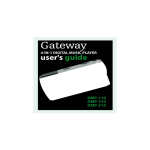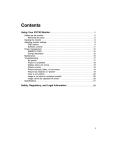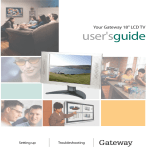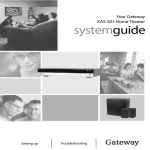Download Gateway GTW-L17M103 User's Manual
Transcript
Your Gateway 17" LCD TV user'sguide Setting up Troubleshooting 09200.book Page i Wednesday, August 13, 2003 9:26 PM Contents 1 Introducing Your Gateway LCD TV . . . . . . . . . . . . . . . . . . . . . . . . . . . . . . . 1 Features . . . . . . . . . . . . . . . . . . . . . . . . . . . . . . . . . . . . . . . . . . . . . . . . . . . . . . . . . . . 2 Important safeguards . . . . . . . . . . . . . . . . . . . . . . . . . . . . . . . . . . . . . . . . . . . . . . . . . 3 Package contents . . . . . . . . . . . . . . . . . . . . . . . . . . . . . . . . . . . . . . . . . . . . . . . . . . . 5 Accessories . . . . . . . . . . . . . . . . . . . . . . . . . . . . . . . . . . . . . . . . . . . . . . . . . . . . . . . . 7 Turning on your LCD TV . . . . . . . . . . . . . . . . . . . . . . . . . . . . . . . . . . . . . . . . . . . . . . 8 Front controls . . . . . . . . . . . . . . . . . . . . . . . . . . . . . . . . . . . . . . . . . . . . . . . . . . . . . . 10 Back panel connections . . . . . . . . . . . . . . . . . . . . . . . . . . . . . . . . . . . . . . . . . . . . . 12 Power, RGB, and DVI connections . . . . . . . . . . . . . . . . . . . . . . . . . . . . . . . . . 13 Audio and video connections . . . . . . . . . . . . . . . . . . . . . . . . . . . . . . . . . . . . . . 14 Remote control . . . . . . . . . . . . . . . . . . . . . . . . . . . . . . . . . . . . . . . . . . . . . . . . . . . . 15 Inserting batteries . . . . . . . . . . . . . . . . . . . . . . . . . . . . . . . . . . . . . . . . . . . . . . . 17 2 Connecting Components . . . . . . . . . . . . . . . . . . . . . . . . . . . . . . . . . . . . . . . 19 Understanding video connections . . . . . . . . . . . . . . . . . . . . . . . . . . . . . . . . . . . . . . Connecting components . . . . . . . . . . . . . . . . . . . . . . . . . . . . . . . . . . . . . . . . . . . . . Using composite video . . . . . . . . . . . . . . . . . . . . . . . . . . . . . . . . . . . . . . . . . . . Using S-Video . . . . . . . . . . . . . . . . . . . . . . . . . . . . . . . . . . . . . . . . . . . . . . . . . . Using coaxial (RF) audio and video . . . . . . . . . . . . . . . . . . . . . . . . . . . . . . . . . Connecting a computer . . . . . . . . . . . . . . . . . . . . . . . . . . . . . . . . . . . . . . . . . . . . . . Using DVI video . . . . . . . . . . . . . . . . . . . . . . . . . . . . . . . . . . . . . . . . . . . . . . . . Using RGB video . . . . . . . . . . . . . . . . . . . . . . . . . . . . . . . . . . . . . . . . . . . . . . . 20 21 21 22 23 24 24 25 3 Adjusting Your LCD TV Settings . . . . . . . . . . . . . . . . . . . . . . . . . . . . . . . . 27 Using the OSD . . . . . . . . . . . . . . . . . . . . . . . . . . . . . . . . . . . . . . . . . . . . . . . . . . . . OSD menus and options (TV, S-Video, Video1, and Video2 mode) . . . . . . . . OSD menus and options (DVI and RGB video mode) . . . . . . . . . . . . . . . . . . . Setting the sleep timer . . . . . . . . . . . . . . . . . . . . . . . . . . . . . . . . . . . . . . . . . . . Using parental controls . . . . . . . . . . . . . . . . . . . . . . . . . . . . . . . . . . . . . . . . . . . Setting a password . . . . . . . . . . . . . . . . . . . . . . . . . . . . . . . . . . . . . . . . . . . . . . 28 29 31 33 34 38 4 Maintenance and Troubleshooting . . . . . . . . . . . . . . . . . . . . . . . . . . . . . . 41 Cleaning and maintenance . . . . . . . . . . . . . . . . . . . . . . . . . . . . . . . . . . . . . . . . . . . Cleaning the screen . . . . . . . . . . . . . . . . . . . . . . . . . . . . . . . . . . . . . . . . . . . . . Cleaning the exterior . . . . . . . . . . . . . . . . . . . . . . . . . . . . . . . . . . . . . . . . . . . . . Troubleshooting . . . . . . . . . . . . . . . . . . . . . . . . . . . . . . . . . . . . . . . . . . . . . . . . . . . . Telephone support . . . . . . . . . . . . . . . . . . . . . . . . . . . . . . . . . . . . . . . . . . . . . . 42 42 42 43 44 i 09200.book Page ii Wednesday, August 13, 2003 9:26 PM A Safety, Regulatory, and Legal Information . . . . . . . . . . . . . . . . . . . . . . .45 Index. . . . . . . . . . . . . . . . . . . . . . . . . . . . . . . . . . . . . . . . . . . . . . . . . . . . . . . . . . . . . . . 51 ii 09200.book Page 1 Wednesday, August 13, 2003 9:26 PM Introducing Your Gateway LCD TV 1 This chapter provides basic information about your Gateway LCD TV. Read this chapter to learn about: ■ Features ■ Warnings and safeguards ■ Package contents ■ Controls and connections 1 09200.book Page 2 Wednesday, August 13, 2003 9:26 PM Chapter 1: Introducing Your Gateway LCD TV Features Your LCD TV features: 2 ■ Bright, flicker-free image ■ Automatic detection and conversion of film content for correct display with minimal motion artifacts (noise) ■ Accurate color processing ■ Picture-in-picture (PIP) ■ Multi-Scan support ■ Selectable fixed/variable audio outputs ■ Built-in internal amplifier and speakers ■ Built-in Digital Visual Interface (DVI) to eliminate the need for digital-to-analog conversion ■ 1280 × 768 XGA support for computer input. www.gateway.com 09200.book Page 3 Wednesday, August 13, 2003 9:26 PM Important safeguards Important safeguards Warning Risk of electric shock - Do not open To reduce the risk of electric shock, do no remove the back cover. There are no user-serviceable parts inside. Removing the back cover voids the warranty. Have your LCD TV repaired by qualified service personnel only. Warnings and precautions ■ Do not place your hands, face, or objects close to the ventilation openings of your LCD TV. The top of your LCD TV gets very hot from exhaust air that is released through the ventilation openings. Burns or personal injuries may occur if you are too close to the LCD TV. Damage may occur if you place any object near the top of your LCD TV. ■ Disconnect all cables before moving your LCD TV. Moving your LCD TV with its cables attached may damage the cables and cause fire or electric shock danger. ■ Do not expose your LCD TV to rain or moisture. ■ Keep your LCD TV away from excessive dust, high temperatures, moisture, or direct sunlight. ■ Use your LCD TV in a well-ventilated area and do not cover the ventilation openings. ■ Do not modify your LCD TV or use an unshielded power cord or video input source cable, or you may experience excessive interference. ■ Disconnect your LCD TV and unplug the power cord when the TV is not used for a long period of time. ■ If the picture displayed is in any way abnormal, turn off your LCD TV, then disconnect it from the electrical outlet. Make sure that your video input source cable is connected correctly, then reconnect your LCD TV to the electrical outlet. ■ Disconnect your LCD TV from the electrical outlet before cleaning or performing maintenance. Do not use liquid or aerosol cleaners. Use only a slightly damp cloth for cleaning. ■ Do not place your LCD TV on an unstable cart, stand, or table. Your LCD TV may fall, causing serious damage. www.gateway.com 3 09200.book Page 4 Wednesday, August 13, 2003 9:26 PM Chapter 1: Introducing Your Gateway LCD TV 4 ■ Do not place your LCD TV on a bed, sofa, rug, or other similar surfaces. ■ Never place your LCD TV near or over a radiator or heat source. ■ Do not install your LCD TV in an enclosed area unless correct ventilation is provided. ■ Your LCD TV should be operated from the type of power source indicated on the label. If the type of available power is unknown, consult your electrician or local power company. ■ Your LCD TV is equipped with a 3-pin grounded plug. The plug will only fit into a grounded power outlet. This is a safety feature. If you cannot plug the power cord into the outlet, contact your electrician. Do not alter the plug because this will defeat the safety feature. ■ Do not rest objects on the power cord and avoid placing the power cord near high traffic areas. ■ Do not overload wall outlets and extension cords because this can result in a risk of fire or electric shock. ■ Unplug your LCD TV and contact qualified service personnel if: ■ The power cord or plug is damaged or frayed. ■ Liquid has been spilled into your LCD TV. ■ Your LCD TV has been exposed to water or moisture. ■ Your LCD TV does not operate normally when the operating instructions are followed. Adjust only those controls that are covered by the operating instructions. Incorrect adjustment of other controls may result in damage which often requires extensive work by a qualified technician to restore your LCD TV to normal operation. ■ Your LCD TV has been dropped or the cabinet has been damaged. www.gateway.com 09200.book Page 5 Wednesday, August 13, 2003 9:26 PM Package contents Package contents Along with your LCD TV, the packaging box contains the following items: Remote control Two AAA batteries CATV cable www.gateway.com 5 09200.book Page 6 Wednesday, August 13, 2003 9:26 PM Chapter 1: Introducing Your Gateway LCD TV Composite cable (AV cable) Power adapter Power cord TV antenna cable User guide 6 www.gateway.com 09200.book Page 7 Wednesday, August 13, 2003 9:26 PM Accessories Accessories You can purchase these optional accessories for your LCD TV: ■ Cable kits. Gateway cable kits consist of high-quality gold cables of various lengths, including: ■ RCA composite video cable ■ S-Video cable ■ RCA audio cable ■ VGA video cable ■ DVI-D video cable Contact Gateway for these and other accessories. www.gateway.com 7 09200.book Page 8 Wednesday, August 13, 2003 9:26 PM Chapter 1: Introducing Your Gateway LCD TV Turning on your LCD TV To turn on your LCD TV: 8 1 Push the two release tabs and remove the cable guard from the rear of your LCD TV. 2 Connect the power adapter to the DC power connector on the back of your LCD TV. 3 Replace the cable guard. www.gateway.com 09200.book Page 9 Wednesday, August 13, 2003 9:26 PM Turning on your LCD TV 4 Plug the power cord into the power adapter, then plug other end of the power adapter into a correctly grounded electrical outlet or surge protector. 5 Press the power button on the front of your LCD TV. The Status LED on the front turns green. Warning For added protection during a lightning storm or when it is left unattended or unused for long periods of time, unplug your LCD TV from the wall outlet and disconnect the antenna or cable system. www.gateway.com 9 09200.book Page 10 Wednesday, August 13, 2003 9:26 PM Chapter 1: Introducing Your Gateway LCD TV Front controls Headphone Jack Mute Remote Control Exit Sensor Menu 10 Volume and Channel – and + www.gateway.com Power Input 09200.book Page 11 Wednesday, August 13, 2003 9:26 PM Front controls Button Description Headphone jack Connects headphones. Remote control sensor Receives signals from the remote control. Do not block. Menu Opens the on-screen display (OSD) and OSD menus. Mute/Exit Mutes the volume. OSD active: Exits the OSD. Volume and Increases or decreases the volume. OSD active: Selects OSD menus and menu options. For more information, see “Using the OSD” on page 28. Channel – and + Changes the channel. OSD active: Adjusts OSD options. For more information, see “Using the OSD” on page 28. Input Switches between available video input sources. Power Turns your LCD TV on and off. When you turn your LCD TV on or off, wait three seconds before pressing this button again. www.gateway.com 11 09200.book Page 12 Wednesday, August 13, 2003 9:26 PM Chapter 1: Introducing Your Gateway LCD TV Back panel connections Audio and Video Connections Power, RGB, and DVI Connections Connector Description Power, RGB, and DVI connections See “Power, RGB, and DVI connections” on page 13. Audio and video connections See “Audio and video connections” on page 14. 12 www.gateway.com 09200.book Page 13 Wednesday, August 13, 2003 9:26 PM Back panel connections Power, RGB, and DVI connections You must remove the cable guard to access these connections. For more information, see “Turning on your LCD TV” on page 8. DC Power Analog In (RGB) Digital In (DVI) PC Audio In Connector Description DC Power Connects to the power adapter. Digital In (DVI) Connects to a DVI video device, such as a computer or set-top box. Analog In (RGB) Connects to an RGB video device, such as a computer or set-top box. PC Audio In Connects to your computer’s audio out jack. www.gateway.com 13 09200.book Page 14 Wednesday, August 13, 2003 9:26 PM Chapter 1: Introducing Your Gateway LCD TV Audio and video connections You must remove the video connection panel to access these connections. TV In S-Video Video In (Video1) Audio In L (Video1) Audio In R (Video1) Video In (Video2) Audio In L (Video2) Audio In R (Video2) TV Audio Out TV Video Out Connector Description TV In Connects to a VHF/UHF antenna or cable TV. S-Video Connects to an S-Video device, such as a satellite dish receiver or digital cable box. Video In Connects to a composite audio/video device, such as a VCR. Audio In L Connects to a composite audio/video device, such as a VCR. Audio In R Connects to a composite audio/video device, such as a VCR. TV Audio Out Connects to an audio device, such as a receiver. TV Video Out Connects to a video device, such as a VCR. 14 www.gateway.com 09200.book Page 15 Wednesday, August 13, 2003 9:26 PM Remote control Remote control Button Function POWER. Turns the LCD TV on and off. AUDIO SOURCE. Selects the audio source when PIP mode is active. INFO. Shows the current status of your LCD TV, such as the video input source, audio status, and channel number. SLEEP. Turns on the sleep timer. PC. Selects analog or digital PC mode. PIP. Turns PIP (picture-in-picture) mode on and off. Only available in PC mode. TV. Selects TV input. VIDEO. Selects the component connected to S-Video, Video1, or Video2 as the input source. Channel + and –. Changes the channel and adjusts OSD options. VOL and . Increases or decreases the volume, selects OSD menus and menu options. MENU. Opens the OSD and OSD menus. For more information, see “Using the OSD” on page 28. www.gateway.com 15 09200.book Page 16 Wednesday, August 13, 2003 9:26 PM Chapter 1: Introducing Your Gateway LCD TV Button Function EXIT. Exits the OSD. Aspect. Cycles through standard and widescreen viewing modes. MUTE. Turns the sound on and off. Number button pad. Selects a channel or enters a password. LAST CHANNEL. Recalls the previously viewed channel. 100. Enters channel numbers greater than 100. 16 www.gateway.com 09200.book Page 17 Wednesday, August 13, 2003 9:26 PM Remote control Inserting batteries To install batteries: ■ Insert two AAA batteries into the remote control. Make sure that you match the + and – on the batteries with the + and – symbols inside the battery compartment. www.gateway.com 17 09200.book Page 18 Wednesday, August 13, 2003 9:26 PM Chapter 1: Introducing Your Gateway LCD TV 18 www.gateway.com 09200.book Page 19 Wednesday, August 13, 2003 9:26 PM Connecting Components 2 Read this chapter to learn how to connect: ■ DVD players ■ VCRs ■ Off-air TV and cable TV ■ Computers Warning Before connecting any external components, unplug your LCD TV. To restart your LCD TV, see “Turning on your LCD TV” on page 8. 19 09200.book Page 20 Wednesday, August 13, 2003 9:26 PM Chapter 2: Connecting Components Understanding video connections Your LCD TV has three types of standard video connections. You should use the best connection available to get the best display. For example, connect the DVD player to your LCD TV using S-Video instead of composite video. Connection Quality Cable and Connector Description Basic Coaxial (RF). The video and audio signals are both carried in one cable (the other two connection types only handle video, and require separate connections for sound). Coaxial is the only way to connect an antenna to your LCD TV. Good Composite. The video signal is carried through a single “pin.” This connection method is the one that is most commonly found on devices. Better S-Video. The video signal is split into two signals, black-and-white and color. Text displayed on-screen through this connection will be noticeably sharper then composite or coaxial (RF). 20 www.gateway.com 09200.book Page 21 Wednesday, August 13, 2003 9:26 PM Connecting components Connecting components Using composite video Use composite video to connect components such as a DVD player, set top box, VCR, or video camera using either Video1 or Video2 connections. For more information, see “Audio and video connections” on page 14. To connect a component using composite video: or or or 1 Connect the yellow video jack on the back of the component to the yellow video jack on the back of your LCD TV. 2 Connect the red (R) and white (L) audio jacks on the back of the component to the R and L audio jacks on the back of your LCD TV. 3 Press the VIDEO button on the remote control repeatedly to select Video1. www.gateway.com 21 09200.book Page 22 Wednesday, August 13, 2003 9:26 PM Chapter 2: Connecting Components Using S-Video Use S-Video to connect components such as a DVD player, set top box, VCR, or video camera. For more information, see “Audio and video connections” on page 14. To connect a component using S-Video: or or or 22 1 Connect the S-Video jack on the back of the component to the S-Video jack on the back of your LCD TV. 2 Connect the red (R) and white (L) audio jacks on the back of the component to the R and L audio jacks on the back of your LCD TV. 3 Press the VIDEO button on the remote control repeatedly to select S-Video. www.gateway.com 09200.book Page 23 Wednesday, August 13, 2003 9:26 PM Connecting components Using coaxial (RF) audio and video Use coaxial video to connect components such as a cable box, VCR, or antenna. To connect a component using coaxial (RF) audio and video: or or 1 Connect the coaxial (RF) connector from the component to the TV In connector on the back of your LCD TV. 2 Press the TV button on the remote control and select a TV channel. If you have an off-air antenna or cable box, connect your off-air antenna or cable TV cable to the ANT connector on the back of your VCR. Warning If an outdoor antenna or cable system is connected to your LCD TV, make sure that the antenna or cable system is correctly grounded. For more information, see “Television antenna connectors protection (for systems fitted with TV/cable TV tuner cards)” on page 47. www.gateway.com 23 09200.book Page 24 Wednesday, August 13, 2003 9:26 PM Chapter 2: Connecting Components Connecting a computer Using DVI video To connect your computer using DVI video: 24 1 Connect the DVI connector on your computer to the Digital-In (DVI) connector on the back of your LCD TV. 2 Connect the Audio Out jack on your computer to the PC Audio In jack on the back of your LCD TV. 3 Press the PC button on the remote control repeatedly to select DIGITAL. www.gateway.com 09200.book Page 25 Wednesday, August 13, 2003 9:26 PM Connecting a computer Using RGB video To connect your computer using RGB video: 1 Connect the 15-pin Analog-In (RGB) connector on your computer to the RGB In connector on the back of your LCD TV. 2 Connect the Audio Out jack on your computer to the PC Audio In jack on the back of your LCD TV. 3 Press the PC button on the remote control repeatedly to select ANALOG. www.gateway.com 25 09200.book Page 26 Wednesday, August 13, 2003 9:26 PM Chapter 2: Connecting Components 26 www.gateway.com 09200.book Page 27 Wednesday, August 13, 2003 9:26 PM Adjusting Your LCD TV Settings 3 Read this chapter to learn how to adjust your LCD TV settings from the on-screen display (OSD). 27 09200.book Page 28 Wednesday, August 13, 2003 9:26 PM Chapter 3: Adjusting Your LCD TV Settings Using the OSD Your LCD TV features an on-screen display (OSD) that lets you adjust and save contrast, brightness, and other settings. Your LCD TV saves changes you make to the settings, even if you turn off the TV. To adjust settings from the OSD: 1 Press the MENU button on the remote control or the front of your LCD TV. The OSD opens. 2 Press the Volume or button on the remote control or the front of your LCD TV to select an OSD menu. 3 Press the MENU button on the remote control or the front of your LCD TV to open the menu you want. 4 Press the Channel + or – button on the remote control or the front of your LCD TV to select a menu option. 5 Press the Volume or button on the remote control or the front of your LCD TV to adjust the option setting. 6 Press the EXIT button on the remote control or the front of your LCD TV to exit the OSD. If you are using TV, S-Video, Video1, or Video2 for your video source, go to “OSD menus and options (TV, S-Video, Video1, and Video2 mode)” on page 29. If you are using DVI or RGB for your video source, go to “OSD menus and options (DVI and RGB video mode)” on page 31. 28 www.gateway.com 09200.book Page 29 Wednesday, August 13, 2003 9:26 PM Using the OSD OSD menus and options (TV, S-Video, Video1, and Video2 mode) You can use these OSD menus and options to adjust various settings for your LCD TV. OSD Menu Description Image Brightness. Adjusts the brightness of the picture. You may need to readjust brightness after the LCD TV warms up. TV Image Tint. Adjusts the color of flesh tones. CH SCAN CH EDIT Contrast. Adjusts the contrast of the picture. Sharpness. Adjusts the amount of detail enhancement. Ch Scan. When this option is selected, your LCD TV adds all channels that have a signal to the channel list. Only available in TV mode. Ch Edit. Adds the channel to the channel list. Delete removes the channel from the channel list. Only available in TV mode. Reset. Resets picture settings to the factory default. Sound Volume. Adjusts the volume level. Treble. Adjusts the treble. TV Image Bass. Adjusts the bass. Sound Image TREBLE BALANCE BASS Basic Setting Balance. Adjusts the balance level between the speakers. MODE Mute. Mutes the volume. Mode. Changes the sound output. Switch between Mono, Stereo, or Sap (Second Audio Program) for audio simulcasts. The TV program must support the output option. Only available in TV mode. www.gateway.com 29 09200.book Page 30 Wednesday, August 13, 2003 9:26 PM Chapter 3: Adjusting Your LCD TV Settings OSD Menu Description Other Tuner Source. Sets the source for the tuner. Select Cable for cable, or Air for an antenna. TV Image TV Sound Other A1_ Other Setting 30 Closed Caption. Activates and selects the closed captioning option. Parental Control. Activates parental controls. You need the remote control to use this option. For more information, see “Using parental controls” on page 34. Password. Changes the password for the parental control screens. You need the remote control to use this option. For more information, see “Setting a password” on page 38. www.gateway.com 09200.book Page 31 Wednesday, August 13, 2003 9:26 PM Using the OSD OSD menus and options (DVI and RGB video mode) Basic Auto Adjust. Automatically adjusts the settings for the video input source. PC Basic 1920 X 1080 Color Sound Brightness. Adjusts the brightness of the picture. 60Hz Other PIP AUTO You may need to readjust brightness after the LCD TV warms up. Contrast. Adjusts the contrast of the picture. Phase. Removes any horizontal distortion and clears or sharpens the displayed characters. Basic Setting Clock. Removes any vertical distortion and clears or sharpens the displayed characters. H-Position. Adjusts the horizontal screen position. V-Position. Adjusts the vertical screen position. Color PC Basic K 1920 X 1080 Color Sound G B 60Hz Other R G B B R Color. Adjusts the color to a preset mode. You can also customize the red, green and blue separately. PIP R G Adjust the Color www.gateway.com 31 09200.book Page 32 Wednesday, August 13, 2003 9:26 PM Chapter 3: Adjusting Your LCD TV Settings Sound Volume. Adjusts the volume level. Treble. Adjusts the treble. PC Basic 1920 X 1080 Color TREBLE Sound BASS 60Hz Other Bass. Adjusts the bass. PIP Mute. Mutes the volume. PC PIP BALANCE Balance. Adjusts the balance level between the speakers. PC/PIP. Changes the sound output. Switch between PC or PIP. Sound Only available when PIP mode is active. Other Language. Changes the language of the OSD menu. PC 1920 X 1080 OSD H-Position. Adjusts the horizontal position of the OSD within the display image. 60Hz PIP OSD V-Position. Adjusts the vertical position of the OSD within the display image. Graph/Text. Adjusts the amount of detail enhancement and clears or sharpens the displayed characters. Expand. Adjusts the screen width. WXGA/XGA. Sets the video input source. Reset. Resets picture settings to the factory default. PIP PC Basic 1920 X 1080 Color Sound Other When PIP is turned on, you can display two pictures at one time. The picture on the full screen is the computer display. The picture in the window is the sub-picture. 60Hz PIP PIP mode only works when the picture displayed on the full screen comes from the DVI or RGB video input. The sub-picture video input source can be set to the TV, S-Video, Video1, or Video2. PIP Setting Image On/Off. Turns PIP off and on. PIP Size. Sets the size of the PIP window. H-Position. Moves the sub-picture left or right. V-Position. Moves the sub-picture up or down. PIP Source. Changes the video input source of the sub-picture when PIP is turned on. 32 www.gateway.com 09200.book Page 33 Wednesday, August 13, 2003 9:26 PM Using the OSD Setting the sleep timer The sleep timer lets you set a time delay to turn off your LCD TV automatically. To set the sleep timer using the remote control: 1 Press the SLEEP button on the remote control. The sleep timer appears in the bottom left corner of your screen. 2 Press the SLEEP button one or more times to select the time you want. To turn off the sleep timer using the remote control: ■ Press the SLEEP button repeatedly until OFF Timer _ _ Min appears. www.gateway.com 33 09200.book Page 34 Wednesday, August 13, 2003 9:26 PM Chapter 3: Adjusting Your LCD TV Settings Using parental controls The parental controls feature prevents viewers from watching programs that are not age-appropriate, such as programs containing violence or adult language. To set the parental controls: 1 2 Press the MENU button on remote control to open the OSD. Press the Volume and buttons on the remote control to select Other, then press the MENU button on the remote control to open the Other menu. TV Image Sound Other A1_ TV Other Setting 3 Press the Volume and buttons to select the Parental Control sub-menu. Enter Password < Input 4 Digit> 34 www.gateway.com 09200.book Page 35 Wednesday, August 13, 2003 9:26 PM Using the OSD 4 Use the number pad to enter your password when prompted. If you have not set a password, enter 0000. For more information about setting a password, see “Setting a password” on page 38. TV Image Sound Other A1_ TV Parental Control MPAA TV Guidelines + 5 Press the Channel – button to select the MPAA sub-menu. MPAA G PG PG-13 NC-17 X EXIT:EXIT [_____] [_____] [_____] [_____] [_____] SELECT:MENU On this menu you can select the following MPAA movie ratings: ■ G (general audience) ■ PG (parental guidance suggested) ■ PG-13 (recommended for children 13 years of age and older) ■ R (mature audience) ■ NC-17 (no one under 17 years of age) ■ X (no one under 17 years of age) www.gateway.com 35 09200.book Page 36 Wednesday, August 13, 2003 9:26 PM Chapter 3: Adjusting Your LCD TV Settings 6 Press the Channel + or – buttons to select each rating, and press MENU to set the rating to BLOCKED. Press the MENU button again to unblock the rating. 7 8 Press EXIT to return to the Parental Controls menu. Press the Channel + button to select the TV Guidelines sub-menu. TV Guidelines TV-Y TV-Y7 TV-G TV-PG TV-14 [_____] [_____] [_____] [_____] [_____] [_____] TV-MA BLOCK CONTENT>> EXIT:EXIT SELECT:MENU On this menu, you can block the following TV ratings: ■ Y (all children) ■ Y7 (older children) ■ G (general audience) ■ PG (guidance suggested) ■ 14 (strongly cautioned) ■ MA (mature audience) You can also select BLOCK CONTENT to customize TV ratings for the following content: 36 ■ FV (fantasy violence) ■ D (sexual dialog) ■ L (adult language) ■ S (sexual situations) ■ V (violence) www.gateway.com 09200.book Page 37 Wednesday, August 13, 2003 9:26 PM Using the OSD 9 Press the Channel + or – buttons to select each rating, press MENU to set the total rating to BLOCKED, then press EXIT to return to the Parental Control menu. - OR Select BLOCK CONTENT to customize the rating, and press MENU. BLOCK CONTENT Y Y7 FV G PG D 14 D L L S S MA L S EXIT:EXIT V V V SELECT:MENU 10 Press the Channel + , – and Volume and buttons to select each rating, then press MENU to set the rating to BLOCKED. Press the MENU button again to unblock the rating. 11 Press EXIT twice to return to the Parental Control menu. www.gateway.com 37 09200.book Page 38 Wednesday, August 13, 2003 9:26 PM Chapter 3: Adjusting Your LCD TV Settings Setting a password You control access to the parental controls with a password. The default password is 0000. You can change the password to any four-digit number. To change the security password: 1 2 Press the MENU button on remote control to open the OSD. Press the Volume and buttons on the remote control to select Other, then press the MENU button on the remote control to open the Other menu. TV Image Sound Other A1_ TV Other Setting 3 Press the Volume and buttons to select the Parental Control sub-menu. Enter Password < Input 4 Digit> 38 www.gateway.com 09200.book Page 39 Wednesday, August 13, 2003 9:26 PM Using the OSD 4 Use the number pad to enter your password when prompted. If you have not set a password, enter 0000. TV Image Sound Other A1_ TV Parental Control MPAA TV Guidelines + 5 Press the Volume button to select the Password sub-menu. TV Image TV A1_ 6 Sound Other A1_ Password Change + Press the Channel + button to select Change, then use the number button pad to enter a new four-digit password when prompted. Change Password < Input 4 Digit> www.gateway.com 39 09200.book Page 40 Wednesday, August 13, 2003 9:26 PM Chapter 3: Adjusting Your LCD TV Settings Resetting your customized password If you forget your password there is a way to reset it. To reset the security password: 1 2 3 Turn on the LCD TV. Press the TV button on the remote control. Press and hold the Volume and buttons on the remote control or the front of your LCD TV for three (3) seconds. The Password Clear message box opens. The password is reset to 0000. 40 www.gateway.com 09200.book Page 41 Wednesday, August 13, 2003 9:26 PM Maintenance and Troubleshooting 4 Read this chapter to learn how to maintain and troubleshoot your LCD TV. 41 09200.book Page 42 Wednesday, August 13, 2003 9:26 PM Chapter 4: Maintenance and Troubleshooting Cleaning and maintenance Cleaning the screen ■ Do not use substances such as glass cleaners, solvents, and thinners. ■ The screen of your LCD TV has been specially treated. Wipe the surface gently using only a cleaning cloth or a soft, lint-free cloth. ■ If the surface is particular dirty, use a soft cloth and water to clean the screen. Squirt a little water on the cloth (never directly on the screen), then wipe the screen with the cloth. Warning The screen of your LCD TV is made of specially coated glass and can be scratched or damaged by abrasive or ammonia-based window cleaners. Scratches on the bezel or glass are not covered by your warranty. ■ Do not scratch or hit the surface of the screen with your fingers or any hard objects. Cleaning the exterior 42 ■ Your LCD TV is cooled by air circulated through the vents on the case, so keep the vents free of dust. With your LCD TV turned off and unplugged, brush the dust away from the vents with a damp cloth. Be careful not to drip any water into the vents. Do not attempt to clean dust from the inside of your LCD TV. ■ Do not use abrasive or solvent cleaners because they can damage the finish on components. ■ Do not allow any excessive water or moisture to come into contact with the surface of your LCD TV. If water or moisture gets inside your LCD TV, operating problems and electrical and shock hazards may result. ■ Do not scratch or hit the cabinet with your fingers or any hard objects. ■ Do not place articles made from rubber or PVC near the cabinet for any extended periods of time. www.gateway.com 09200.book Page 43 Wednesday, August 13, 2003 9:26 PM Troubleshooting Troubleshooting Use the following information to solve common problems. You cannot see a picture ■ Make sure that the power cord is plugged into a grounded electrical outlet. ■ Make sure that the power button is turned on. ■ Make sure that the selected input source is connected to a working input source. ■ Press the INPUT button on the front of your LCD TV until you select the correct input source. ■ If your LCD TV is connected to your computer in RGB or DVI mode, press any key on your keyboard to “wake” your computer. You see a distorted picture or hear unusual sound ■ You may be getting interference from electrical appliances, cars, motorcycles, or fluorescent lights. Try moving your LCD TV to another location. The color is abnormal ■ Make sure that the input source cable is connected securely and correctly to the back of your LCD TV. The picture has abnormal patterns ■ Make sure that the input source cable is attached securely and correctly. ■ Make sure that the video input source is within the range of your LCD TV. Compare the video input source’s specifications with your LCD TV specifications. The display image does not cover the entire screen ■ If you are using RGB or DVI mode, make sure that Aspect Ratio in the OSD is set correctly. ■ If you are using TV, S-Video, Video1, or Video2 mode, use the Aspect button on the remote control to scroll through various screen modes. www.gateway.com 43 09200.book Page 44 Wednesday, August 13, 2003 9:26 PM Chapter 4: Maintenance and Troubleshooting You can see a picture but you cannot hear sound ■ Make sure that the volume is not turned down. ■ Make sure that the sound is not muted. ■ Make sure that your audio input source cables are connected securely and correctly. The monitor has pixels that are always dark ■ Your LCD TV is manufactured using an extremely high level of precision technology. However, sometimes some pixels of your LCD TV may not display. Pixel defects within industry specifications are inherent to this type of product and do not constitute a defective product. You see “noise” or “trash” on the screen ■ When your LCD TV’s digital capabilities exceed a digital broadcast signal, the signal is up-converted (increased) to match your LCD TV’s display capabilities. Up-converting can cause noise or trash. Screen brightness is diminished ■ Video display devices experience degradation of brightness over the life of the device. Normal brightness degradation is not covered by your warranty. Telephone support If this troubleshooting information does not resolve your problem or if you have other questions relating to your LCD TV, call our Service Center at 888-737-MyGW (6949). For more information about Gateway, visit www.gateway.com. 44 www.gateway.com 09200.book Page 45 Wednesday, August 13, 2003 9:26 PM Safety, Regulatory, and Legal Information A Regulatory compliance statements United States of America Federal Communications Commission (FCC) Unintentional emitter per FCC Part 15 This device has been tested and found to comply with the limits for a Class B digital device, pursuant to Part 15 of the FCC rules. These limits are designed to provide reasonable protection against harmful interference in a residential installation. 45 09200.book Page 46 Wednesday, August 13, 2003 9:26 PM Safety, Regulatory, and Legal Information This equipment generates, uses, and can radiate radio frequency energy and, if not installed and used in accordance with the instructions, may cause harmful interference to radio or television reception. However, there is no guarantee that interference will not occur in a particular installation. If this equipment does cause interference to radio and television reception, which can be determined by turning the equipment off and on, the user is encouraged to try to correct the interference by one or more of the following measures: ■ Reorient or relocate the receiving antenna ■ Increase the separation between the equipment and receiver ■ Connect the equipment to an outlet on a different circuit from that to which the receiver is connected ■ Consult the dealer or an experienced radio/TV technician for help. Compliance Accessories: The accessories associated with this equipment are: shielded video cable when an external monitor is connected. These accessories are required to be used in order to ensure compliance with FCC rules. FCC declaration of conformity Responsible party: Gateway Companies, Inc. 610 Gateway Drive, North Sioux City, SD 57049 (605) 232-2000 Fax: (605) 232-2023 Product: ■ GTW-L17M103 LCD TV This device complies with Part 15 of the FCC Rules. Operation of this product is subject to the following two conditions: (1) this device may not cause harmful interference, and (2) this device must accept any interference received, including interference that may cause undesired operation. Caution Changes or modifications not expressly approved by Gateway could void the FCC compliance and negate your authority to operate the product. Canada Industry Canada (IC) Unintentional emitter per ICES-003 This digital apparatus does not exceed the Class B limits for radio noise emissions from digital apparatus as set out in the radio interference regulations of Industry Canada. Le présent appareil numérique n’émet pas de bruits radioélectriques dépassant les limites applicables aux appareils numériques de Classe B prescrites dans le règlement sur le brouillage radioélectrique édicté par Industrie Canada. 46 www.gateway.com 09200.book Page 47 Wednesday, August 13, 2003 9:26 PM Regulatory compliance statements Laser safety statement All Gateway systems equipped with CD and DVD drives comply with the appropriate safety standards, including IEC 825. The laser devices in these components are classified as “Class 1 Laser Products” under a US Department of Health and Human Services (DHHS) Radiation Performance Standard. Should the unit ever need servicing, contact an authorized service location. Warning Use of controls or adjustments or performance of procedures other than those specified in this manual may result in hazardous radiation exposure. To prevent exposure to laser beams, do not try to open the enclosure of a CD or DVD drive. California Proposition 65 Warning Warning This product contains chemicals, including lead, known to the State of California to cause cancer and/or birth defects or reproductive harm. Television antenna connectors protection (for systems fitted with TV/cable TV tuner cards) External television antenna grounding If an outside antenna or cable system is to be connected to your Gateway PC, make sure that the antenna or cable system is electrically grounded to provide some protection against voltage surges and static charges. Article 810 of the National Electrical Code, ANSI/NFPSA 70, provides information with regard to proper grounding of the mast and supporting structure, grounding of the lead-in wire to an antenna discharge unit, size of grounding conductors, location of antenna discharge unit, connection to grounding electrodes, and requirements for the grounding electrode. Lightning protection For added protection of any Gateway product during a lightning storm or when it is left unattended or unused for long periods of time, unplug the product from the wall outlet and disconnect the antenna or cable system. www.gateway.com 47 09200.book Page 48 Wednesday, August 13, 2003 9:26 PM Safety, Regulatory, and Legal Information Power lines Do not locate the antenna near overhead light or power circuits, or where it could fall into such power lines or circuits. Warning When installing or realigning an outside antenna system, extreme care should be taken to keep from touching such power lines or circuits. Contact with them could be fatal. 7 6 5 4 3 1 2 Antenna and satellite grounding 48 Reference Grounding component 1 Electric service equipment 2 Power service grounding electrode system (NEC Art 250, Part H) 3 Ground clamps 4 Grounding conductors (NEC Section 810-21) 5 Antenna discharge unit (NEC Section 810-20) 6 Ground clamp 7 Antenna lead-in wire www.gateway.com 09200.book Page 49 Wednesday, August 13, 2003 9:26 PM Notices Notices Copyright © 2003 Gateway, Inc. All Rights Reserved 14303 Gateway Place Poway, CA 92064 USA All Rights Reserved This publication is protected by copyright and all rights are reserved. No part of it may be reproduced or transmitted by any means or in any form, without prior consent in writing from Gateway. The information in this manual has been carefully checked and is believed to be accurate. However, changes are made periodically. These changes are incorporated in newer publication editions. Gateway may improve and/or change products described in this publication at any time. Due to continuing system improvements, Gateway is not responsible for inaccurate information which may appear in this manual. For the latest product updates, consult the Gateway Web site at www.gateway.com. In no event will Gateway be liable for direct, indirect, special, exemplary, incidental, or consequential damages resulting from any defect or omission in this manual, even if advised of the possibility of such damages. In the interest of continued product development, Gateway reserves the right to make improvements in this manual and the products it describes at any time, without notices or obligation. Trademark Acknowledgments 1-800-GATEWAY, ActiveCPR, ALR, AnyKey, black-and-white spot design, CrystalScan, Destination, DestiVu, EZ Pad, EZ Point, Field Mouse, Gateway 2000, Gateway Country, gateway.net, Gateway stylized logo, Perfect Scholar, Solo, TelePath, Vivitron, stylized “G” design, and “You’ve got a friend in the business” slogan are registered trademarks and black-and-white spotted box logo, GATEWAY, Gateway Astro, Gateway@Work, Gateway Connected touch pad, Gateway Connected music player, Gateway Cyber:)Ware, Gateway Education:)Ware, Gateway Flex Case, Gateway Gaming:)Ware, Gateway GoBack, Gateway Gold, Gateway Learning:)Ware, Gateway Magazine, Gateway Micro Server, Gateway Money:)Ware, Gateway Music:)Ware, Gateway Networking Solutions, Gateway Online Network (O.N.) solution, Gateway Photo:)Ware, Gateway Professional PCs, Gateway Profile, Gateway Solo, green stylized GATEWAY, green stylized Gateway logo, Gateway Teacher:)Ware, Gateway Video:)Ware, HelpSpot, InforManager, Just click it!, Learn@Gateway, Kids BackPack, SERVE-TO-ORDER, Server Watchdog, the Spotted G Gateway Logo and the Spotted G Logo, SpotShop, Spotshop.com, and Your:)Ware are trademarks of Gateway, Inc. Intel, Intel Inside logo, and Pentium are registered trademarks and MMX is a trademark of Intel Corporation. Microsoft, MS, MS-DOS, and Windows are trademarks or registered trademarks of Microsoft Corporation. All other product names mentioned herein are used for identification purposes only, and may be the trademarks or registered trademarks of their respective companies. www.gateway.com 49 09200.book Page 50 Wednesday, August 13, 2003 9:26 PM Safety, Regulatory, and Legal Information 50 www.gateway.com 09200.book Page 51 Wednesday, August 13, 2003 9:26 PM Index A accessories 7 adjust brightness 29, 31 color 31 contrast 29, 31 screen width 32 sound 29, 32 TV settings 29 antenna connecting 23 connection 14 audio and video connection 12, 14 audio in connection 14 audio out connection 14 B back panel connections 12 Basic menu 31 batteries 5 installing 17 brightness 29, 31 C cable kits 7 cable TV connecting 23 connection 14 CATV cable 5 channel up and down buttons 11, 28 cleaning 42 exterior 42 screen 42 closed captioning 30 coaxial (RF) video 20 connecting 23 connection 14 color 31 Color menu 31 composite cable 6 composite video 20 connecting 21 connection 14 computer connecting 24 connecting DVI video 24 connecting RGB video 25 connecting antenna 23 cable TV 23 computer 24 DVD player 21, 22 power cord 8 VCR 21, 22, 23 video camera 21, 22 connections antenna 14 audio 14 audio and video 12 audio in 14 back panel 12 cable TV 14 composite video 14 DC power 13 DVI 12, 13 DVI in 13 PC audio in 13 RGB 12, 13 RGB in 13 S-Video 14 TV in 14 video 14 contrast 29, 31 D DC power 13 DVD player connecting 21, 22 DVI connection 12, 13 DVI in connection 13 51 09200.book Page 52 Wednesday, August 13, 2003 9:26 PM headphone jack 11 PIP menu 32 PIP mode 32 power adapter 6 power button 11 power cord 6 connection 8 I R Image menu 29 input button 11 remote control 5 buttons 15 sensor 11 RGB connection 12, 13 RGB in connection 13 F features 2 front controls 10 H M maintenance 41, 42 menu button 11, 28 mute/exit button 11 O on-screen display see OSD OSD 28 brightness 29, 31 closed captioning 30 Color menu 31 contrast 29, 31 Image menu 29 Main menu 31 Other menu 30, 32 parental controls 30 password 30 PIP menu 32 PIP mode 32 screen width 32 Sound menu 29, 32 Other menu 30, 32 P parental controls 30 setting 34 password 30, 35, 39 changing 38, 40 resetting 40 setting 38 PC audio in connection 13 52 S safety 3 screen width 32 Service Center 44 setting up safety precautions 3 sleep timer 33 setting 33 turn off 33 sound 29, 32 Sound menu 29, 32 support 44 S-Video 20 connecting 22 connection 14 T troubleshooting 41, 43 TV antenna cable 6 TV in connection 14 TV settings 29 V VCR connecting 21, 22, 23 video camera connecting 21, 22 video connections 14 types of 20 volume left and right buttons 11, 28, 40 MAN MON 17" LCD TV GDE R0 6/03















































































